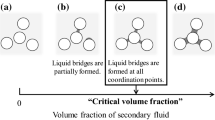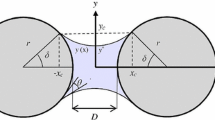Abstract
We investigated the behavior of a water liquid bridge formed between two grains. We mainly focused on tensile tests with suction control (capillary pressure). Theoretical and experimental studies are compared. A new experimental device involving suction control of the liquid bridge was developed specifically for this kind of test. Most of the liquid bridge variables and characteristics were measured by image analysis (gorge radius, volume, contact angles, filling angles). Capillary force was measured by differential weighting. Experimental conditions allows us to avoid viscous effects. Our experimental results were close to Young-Laplace equation solutions. The “gorge method”, commonly used for calculating the capillary force, was also validated by our experiments. Liquid bridge rupture was studied and a new rupture criterion is proposed. This criterion depends on the grain radius, contact angle, surface tension and suction and was in agreement with the experimental results.
















Similar content being viewed by others
References
Schiffer, P.: Granular physics: a bridge to sandpile stability. Nat. Phys. 1, 21–22 (2005)
Richefeu, V., El Youssoufi, M.S., Azéma, E., Radjaï, F.: Force transmission in dry and wet granular media. Powder Technol. 190, 258–263 (2009)
Scheel, M., Seemann, R., Brinkmann, M., Di Michiel, M., Sheppard, A., Herminghaus, S.: Liquid distribution and cohesion in wet granular assemblies beyond the capillary bridge regime. J. Phys.: Condens. Matter 20, 494236, (7pp.) (2008)
Mikami, T., Kamiya, H., Horio, M.: Numerical simulation of cohesive powder behavior in a fluidized bed. Chem. Eng. Sci. 53(10), 1927–1940 (1998)
Pitois, O., Moucheront, P., Chateau, X.: Liquid bridge between two moving spheres: an experimental study of viscosity effects. J. Colloid Interface Sci. 231, 26–31 (2000)
Soulié, F., El Youssoufi, M.S., Cherblanc, F., Saix, C.: Capillary cohesion and mechanical strength of polydisperse granular materials. Eur. Phys. J. E 21, 349–357 (2006)
Richefeu, V., El Youssoufi, M.S., Peyroux, R., Radjaï, F.: A model of capillary cohesion for numerical simulations of 3d polydisperse granular media. Int. J. Numer. Anal. Methods Geomech. 32(11), 1365–1383 (2008)
Molenkamp, F., Nazemi, A.H.: Interactions between two rough spheres, water bridge and water vapour. Géotechnique 53, 255–264 (2003)
Likos, J.W., Lu, N.: Hysteresis of capillary stress in unsaturated granular soil. J. Eng. Mech. 130, 646–655 (2004)
Lechman, J., Lu, N.: Capillary force and water retention between two uneven-sized particles. J. Eng. Mech. 134(5), 374–384 (2008)
El Shamy, U., Gröger, T.: Micromechanical aspects of the shear strength of wet granular soils. Int. J. Numer. Anal. Methods Geomech. 32, 1763–1790 (2008)
Scholtès, L.: Modélisation Micro-Mécanique des Milieux Granulaires Partiellement Saturés. PhD thesis, Institut National Polytechnique de Grenoble, (2008)
Mason, G., Clark, W.C.: Liquid bridges between spheres. Chem. Eng. Sci. 20, 859–866 (1965)
Hotta, K., Takeda, K., Linoya, K.: The capillary binding force of a liquid bridge. Powder Technol. 10, 231–242 (1974)
Soulié, F.: Cohésion par capillarité et comportement mécanique de milieux granulaires. PhD thesis, Université Montpellier 2, (2005)
Willet, C.D., Adams, M.J., Johnson, S.A., Seville, J.P.K.: Capillary bridges between two spherical bodies. Langmuir 16, 9396–9405 (2000)
Willet, C.D., Adams, J.M., Johnson, S.A., Seville, J.P.K.: Effects of wetting hysteresis on pendular liquid bridges between rigid spheres. Powder Technol 130, 63–69 (2003)
Soulié, F., Cherblanc, F., El Youssoufi, M.S., Saix, C.: Influence of liquid bridges on the mechanical behaviour of polydisperse granular materials. Int. J. Numer. Anal. Methods Geomech. 30, 213–228 (2006)
Gras, J.-P.: Approche micromécanique de la capillarité dans les milieux granulaires: rétention d’eau et comportement mécanique. PhD thesis, Université Montpellier 2 (2011)
Gras, J.-P., Delenne, J.-Y., Soulié, F., El Youssoufi, M.S.: DEM and experimental analysis of the water retention curve in polydisperse granular media. Powder Technol. 208, 296–300 (2011)
Lian, G., Thornton, C., Adams, J.M.: A theoretical study of the liquid bridge forces between two rigid spherical bodies. J. Colloid Interface Sci. 161, 138–147 (1993)
Rotemberg, Y., Boruvka, L., Neumann, A.W.: Determination of surface tension and contact angle from the shapes of axisymmetric fluid interfaces. J. Colloid Interface Sci. 93(1), 169–183 (1983)
Zeinali, Heris S., Hamed Mosavian, M.T.: Capillary holdup between vertical spheres. Brazilian J. Chem. Eng. 26, 695–704 (2009)
Mazzone, D.N., Tardos, G.I., Pfeffer, R.: The effect of gravity on the shape and strength of a liquid bridge between two spheres. J. Colloid Interface Sci. 113, 544–556 (1986)
Author information
Authors and Affiliations
Corresponding author
Appendix: Effect of gravity
Appendix: Effect of gravity
We consider a vertical liquid bridge under gravity. The effect of gravity decreases the rupture distance, creates distortion in the liquid bridge and changes the capillary forces. Under gravity, a difference of pressure \(\Delta p\) across the liquid/air interface is: \(\Delta p= \Delta p_0 - (\rho _w-\rho _a)gx\) [22, 23]. \(\rho _w\) et \(\rho _a\) are respectively densities of water and air, \(g\) is the acceleration due to gravity, \(\Delta p_0\) is the pressure difference between water and air at the liquid bridge gorge and \(x\) is the vertical position from the gorge section. Then, for a vertical liquid bridge with \(x\) defining the vertical axis, consideration of the gravity on the liquid bridge shape modifies the Young-Laplace differential equation, which becomes:
From this equation, we note that the effect of gravity increases with the interparticle distance [24]. The dimensionless equation becomes:
with \(y^*(x)=\frac{y(x)}{R_{12}},\,x^*=\frac{x}{R_{12}},\,H_{12}^0 =\frac{-\Delta p_0 R_{12}}{\gamma }\) and \(B_0=\frac{(\rho _w-\rho _a)gR_{12}^2}{\gamma }\). In the experimental studies presented, the maximum ratio between the two left terms of the former equation was noted when \(x\) was high. Hence, the variation in water pressure inside the bridge increases as the interparticle distance increases. For example, in the above experiments, the maximum value of this ratio (at rupture) was respectively under 2, 7 and 15 % for suctions of \(140\,Pa,\,70\,Pa\) and \(40\,Pa\). This means that the variation in water pressure inside the bridge due to gravity increases when suction decreases. This explains why the model was more accurate at high suction values. Considering that errors due to gravity are not very marked, we do not have to take gravity into account in our model. Nevertheless, its effects are of interest when analyzing the results.
Rights and permissions
About this article
Cite this article
Gras, JP., Delenne, JY. & El Youssoufi, M.S. Study of capillary interaction between two grains: a new experimental device with suction control. Granular Matter 15, 49–56 (2013). https://doi.org/10.1007/s10035-012-0388-2
Received:
Published:
Issue Date:
DOI: https://doi.org/10.1007/s10035-012-0388-2




